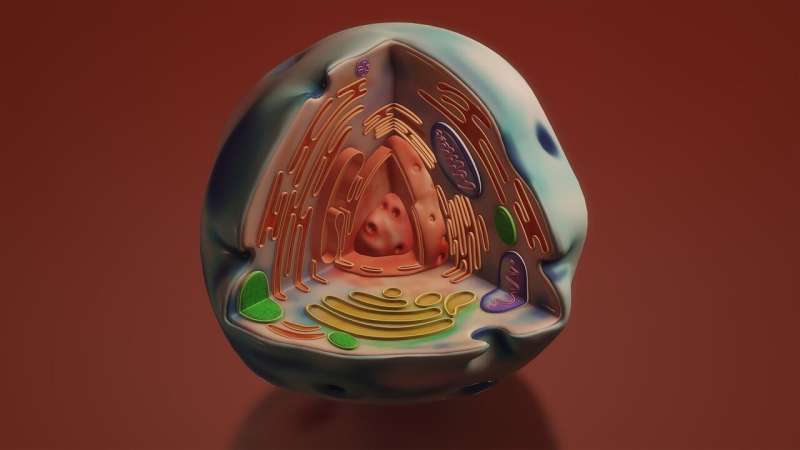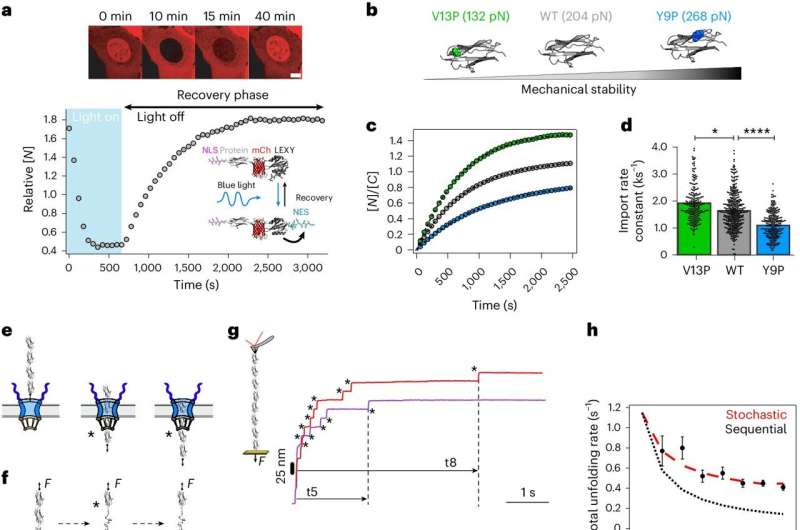This article has been reviewed according to Science X's editorial process and policies. Editors have highlighted the following attributes while ensuring the content's credibility:
fact-checked
peer-reviewed publication
trusted source
proofread
Research shows that 'softer' proteins can cross into the nucleus quicker

Researchers at the Francis Crick Institute and King's College London have discovered that how soft or rigid proteins are in certain regions can dictate how fast or slow they enter the nucleus.
Proteins need to come in and out of the nucleus, the control center of the cell, to give different functions, such as telling the nucleus to switch on or off certain genes. These proteins cross using a channel on the edge of the nucleus called the "nuclear pore complex."
Previous research has shown that the size and composition of these proteins change how easily they can cross, but now this research, published in Nature Physics, has shown that mechanical properties can also influence protein entry through the pore. The paper is titled "Structural anisotropy results in mechano-directional transport of proteins across nuclear pores."
By tracking the movement of proteins in single cells, the team showed that, in proteins of the same size and composition of amino acids (their building blocks), mechanical stability near the protein's 'nuclear-localization sequence' (a special sequence to allow the protein to enter the nucleus) influenced how fast or slow they could cross.
They identified that proteins with a soft or flexible region next to this sequence were able to cross into the nucleus more quickly.

The researchers then engineered a soft tag that could be added near the sequence on stiffer proteins, to help them to enter the nucleus more easily.
This was tested by tagging a transcription factor—a protein that turns certain genes on—called MRTF, which helps cells move around the body. When a soft tag was attached to MRTF, it was able to enter the nucleus much quicker, increasing cell movement.
The researchers believe this could be a potentially useful tool for delivering drugs to the nucleus more quickly, or by tagging transcription factors to increase the activity of certain genes.
Sergi Garcia-Manyes, Group Leader of the Single Molecule Mechanobiology Laboratory at the Francis Crick Institute, and Professor of Biophysics at King's College London, said, "We've made a fundamental discovery that the mechanics of a protein—how soft or stiff it is in the region that leads translocation– control its entry into the cell's nucleus. Although we only looked at the nuclear pore, this mechanism could regulate entry into other parts of the cell, such as the mitochondria or proteasomes. Knowing that a more flexible protein can enter the nucleus quicker could help us design more targeted drugs."
Rafael Tapia-Rojo, co-first author, former postdoc at the Crick, and now lecturer in Biological Physics at King's College London, said, "Our findings were rather unanticipated, and it was striking to see how measurements at the single molecule level can be so directly linked to what happens at a cellular level, using a newly designed optomechanical approach."
The researchers are now investigating how transcription factors have evolved to contain flexible regions that allow them to enter the nucleus more easily.
More information: Panagaki, F. et al. Structural anisotropy results in mechano-directional transport of proteins across nuclear pores, Nature Physics (2024). DOI: 10.1038/s41567-024-02438-8.
Journal information: Nature Physics
Provided by The Francis Crick Institute





















